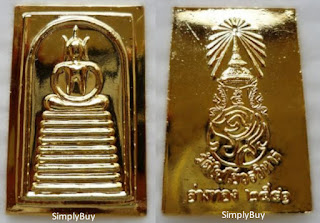This article is dedicated to Wat Keschaiyo somdej votive tablets. We hope all Dharma friends and community members will be able to gain good insight into the history and making of this famous Phra Somdej Wat Keschaiyo. This sacred amulet form which has long ears and sitting on many layers or tiers in mirror frames is associated to Somdej Phra Puttajarn Toh whom is the Chief Abbot of the famous Wat Rakang in Bangkok. From historical records, Somdej Phra Puttajarn also created these form of votive tablet images and only Somdej Wat Rakang had taken the limelight. For serious Somdej votive tablet collectors, we must not ignore the importance of Wat Keschaiyo.
Chiyoworawiharn Monastery is commonly known as Keschaiyo or Kes Monastery. This temple is located at Anthong Province that is about 3 hours journey from Bangkok city. In the past, Somdej Phra Puttajarn Toh travel by the river channel to Bangkok. This monastery was build during Ayuthaya’s period. For a long time this monastery was constructed with a big Buddha image by the name Pra Puttapim or Luanpor Toh. This big image was built using bricks and cement and a huge number of about 84,000 tablets were placed inside. The construction and production of Buddha image tablets was done by the revered Somdej Phra Puttajarn Toh - a highly respected monk by the people of Thailand and even the King.
In the year 1983, the whole monastery was renovated. The piling and construction produced vibrations thus causing Luangpor Toh the big Buddha image to collapse. Many Buddha image amulets known as Pra Somdej Wat Keschaiyo which were contained inside the big Langpor Toh scattered all over the floor. A number of them were kept by the persons respecting the magic of such amulet. The rest were placed into the newly built Luangpor Toh.
Pra Somdej Wat Keschaiyo is made of many sacred ingredients. The finished tablets are like fine marble in the form of rectangular shape with the Buddha sitting on 3 to 7 bases. The head and neck are long and both arms curved together forming somewhat a round shape. The body is hollow with thick laps slightly raised up at both ends. The Buddha’s sitting posture is positioned inside a double frame known as mirror frame. Examples of Somdej Keschaiyo 7 Tier bases and 6 Tier bases are shown below togeher with other beautiful pieces from B.E.2531 and B.E.2540.
 |
| Above displaying 2 vintaged pieces of Somdej Keschaiyo (7 layer base and 6 layer base) |
Below here a few more Somdej Keschaiyo votive tablets for reference.
Self-verification Experience
My story begins during one morning when my old friend suddenly pulled out a very old fashion plastic casing with Black color trimming. He showed it to me and said that he found it inside his old storage box. At first I was sceptical about the origin of this amulet but some knowledge from books told me that it is a Wat Keschaiyo print with 6 bases.
I have a very inquisitive mind trying to find out the truth. In this case it was an old amulet and therefore I requested permission from my friend to analyze this amulet. Well, permission was granted to me without any hesitation. I was able to bring it home for further research using my book resources.
Take a look at the actual amulet (pix). I was not satisfied with the result of my research because that old plastic casing had practically covered 20-30% of the amulet. Verification marks and consideration points for this Hokchan Oktun print is only half met based on my book guidance which is pretty accurate. The book pointed out the most common areas for verifying a genuine piece.
Some other parts like the top and bottom print line was also obscured from eye views due to the plastic casing. Furthermore, the transparent plastic surface (front & back) was not smooth due to ageing thus reducing the visibility even under a magnifying glass. Not feeling satisfied, I contacted my old friend and ask another permission to get the plastic open up for my reseaerch. Guess what? After some persuasion, permission was granted and I rushed straight to an amulet casing shop to get it open.
I was worried and hoping for the best it doen't crack during the process of opening up the casing. That old black colour plastic casing had hardened over a long period of time and it can be a very challenging task even for the amulet casing professional to get it open. At last after a long agonizing 30 minutes of struggling and without cracking the amulet, finally it came out from the old plastic casing. See pix below. A stunning and beautiful work of art from Somdej Toh besides its Buddhistic values.
Once out from the old plastic casing, the feeling was wonderful. Look how beautiful it was - an old Wat Keschaiyo amulet that is more than 100 years old. But my research is far from over until I am satisfied with all the important consideration points and verification marks as per my Green colour book (see below). Under my magnifying glass now I can see clearly all the markings in this Hokchan Oktun piece is in conformance to expert advise in the book.
 |
| Both ends of the knees are slightly curving up |
All the description relating to this Somdej Wat Keschaiyo can be found in the Green colour book displayed here. This book is highly recommended for avid and novice amulet collectors alike. It is a great one-off book investment that will last you a very long time to treasure.
Above is another fine example of a well preserved 6 Level Hollow Chest (Hokchan Talod) Somdej Wat Keschaiyo. Detailed infos can be found inside the Green cover book.
Another piece of small size called "Kanean" B.E.2531 for showcase below.
Now Playing































No comments:
Post a Comment
Note: Only a member of this blog may post a comment.